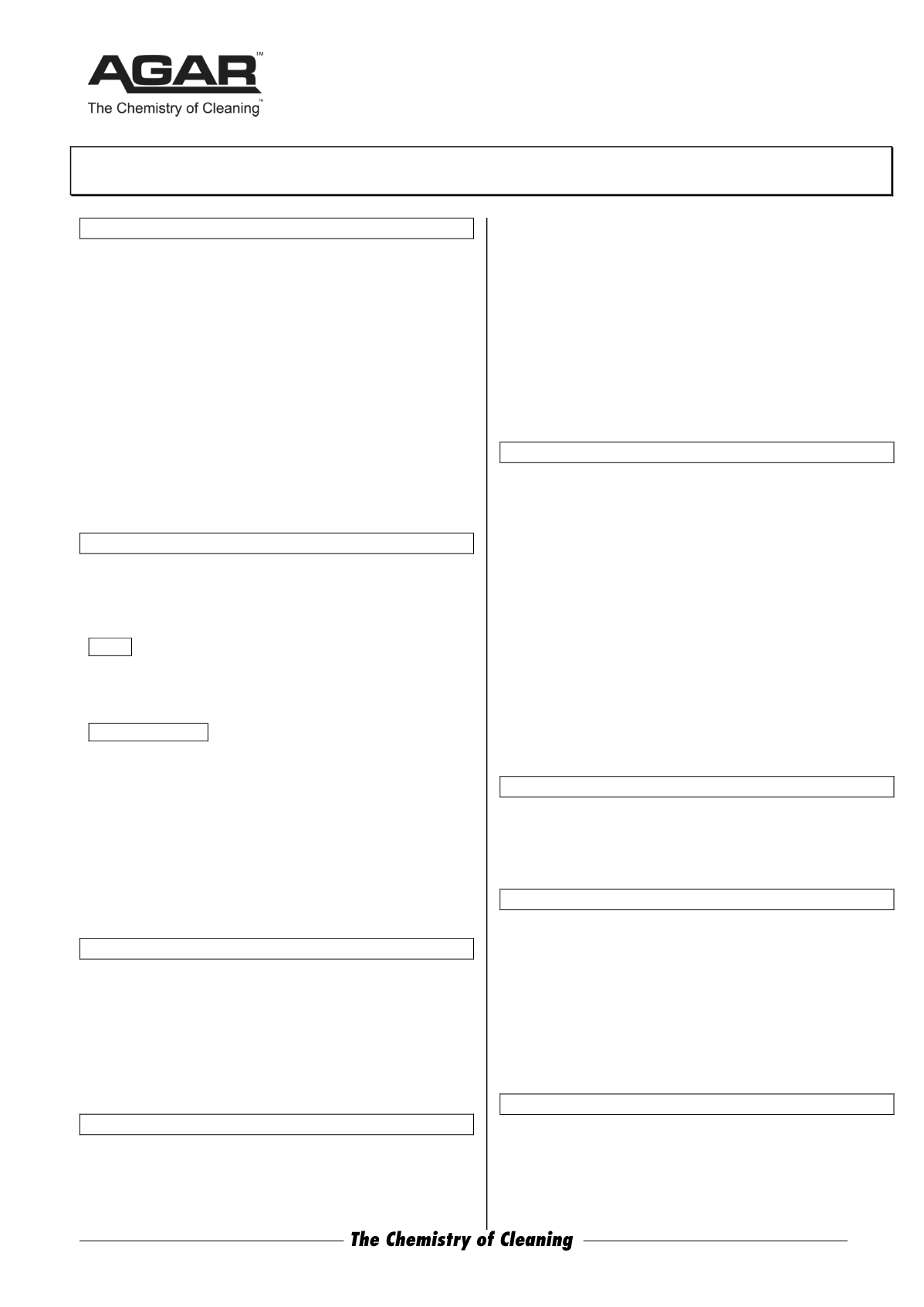

ABN 80 004 726 890 | MADE IN AUSTRALIA
VIC 03 9480 3000
NSW 02 9743 6020
SA 08 8293 2020
QLD 07 3274 3438
WA 08 9249 4566
Safety Data Sheet
Issued: February 25, 2016
Page 1 of 2
DRIVE AWAY
1 IDENTIFICATION OF THE MATERIAL AND SUPPLIER
Product Name:
DRIVE AWAY
Other Names: Flammable Liquid, N.O.S.
Manufacturer's Product Code: DR5, DR20
Product Use: Cleaning oil and grease from hard surfaces
including floors, metal parts and engines. Applied by spray, wipe
or brush.
COMPANY DETAILS
Company: Agar Cleaning Systems Pty. Ltd.
Address: 12-14 Cope Street, Preston, Vic. 3072
Telephone: 03 9480 3000 Facsimile: 03 9480 5100
Web:
www.agar.com.auAgar SDS are available from this website.
E-mail:
admin@agar.com.auEmergency Telephone Number: 131 126
(Aust wide)
2 HAZARDS IDENTIFICATION
Hazardous according to criteria of Safe Work Australia.
Flammable F, Harmful Xn.
Classed as Dangerous Goods.
Risks:
Flammable. [R10]
Irritating to skin. [R38]
Harmful, may cause lung damage if swallowed. [R65]
Safety Directions:
Keep away from sources of ignition – No smoking. [S16]
Keep out of the reach of children. [S2]
Do not breathe vapour. [S23]
Avoid contact with skin. [S24]
If swallowed, do not induce vomiting; seek medical
advice immediately and show this container or
label. [S62]
Keep container in a well-ventilated place. [S9]
Drive Away becomes non-hazardous at concentrations below
20% in water.
3 COMPOSITION / INFORMATION ON INGREDIENTS
Ingredients:
Chemical Entity: CAS No.:
Proportion:
Mineral turpentine
64742-88-7 > 60 %
(benzene content is and 64742-95-6
less than 0.1%)
2-butoxy ethanol
111-76-2 < 10%
Aromatic alcohol
< 10%
Surfactants
-
10 -30 %
4 FIRST AID MEASURES
Poisons Information Centre: Phone 131 126
Swallowed:
If poisoning occurs, contact a doctor or Poisons
Information Centre. If swallowed, do NOT induce vomiting due
to the hazard of solvent aspiration into the lungs. Rinse mouth
with water. Never give anything by mouth to an unconscious
person.
Eye:
Immediately hold the eyes open and wash continuously
for at least 10 minutes with fresh running water. Ensure
irrigation under eyelids by occasionally lifting the upper and
lower lids. Seek medical advice. Removal of contact lenses
after an eye injury should only be undertaken by skilled
personnel.
Skin:
Remove any contaminated clothing and flush area with
water. Seek medical attention in the event of irritation.
Inhaled: If effects occur, remove patient to fresh air, rest
patient and seek medical advice if necessary. Give artificial
respiration if breathing stops.
5 FIRE FIGHTING MEASURES
Fire/Explosion Hazard: Drive Away is combustible.
Flash Point:(turpentine): 39 deg C (COC)
Fire Extinguishing media: Use dry chemical, carbon dioxide or
foam.
Fire Fighters’ PPE: SCBA and structural fire fighter’s uniform
may provide limited protection. Fully-encapsulating, gas-tight
suits should be worn for maximum protection.
Special fire-fighting procedures: Use water to cool exposed
containers. If a leak or spill has ignited, use water spray to
disperse the vapours and to protect men attempting to stop a
leak. Water spray may be used to flush spills away from
exposures. Prevent run off from entering waterways. Minimise
breathing gases, vapour, fumes or decomposition products.
Use supplied-air breathing equipment for enclosed areas.
Unusual fire hazards: None
Hazardous products of combustion: Thermal decomposition in a
large fire may yield carbon dioxide and/or carbon monoxide
and/or hydrocarbons.
6 ACCIDENTAL RELEASE MEASURES
Eliminate all sources of ignition. Ventilate area well. Clean up all
spills immediately. Avoid contact with skin and eyes. Contain
spill for salvage or absorb in inert absorbent material. Place in a
suitable, labelled container for waste disposal.
7 HANDLING AND STORAGE
Storage and Transport: Store in a cool, dry place. Store with all
the precautions required for handling a flammable liquid.
Observe State Regulations concerning the storage and
handling of Dangerous Goods.
Class 3 Flammable Liquids shall not be loaded in the same
vehicle with: Classes 1, 2.1, 2.3, 4.2, 5.1, 5.2 or 7.
Incompatibility (Materials to avoid for purposes of transport,
handling and storage only): Oxidising agents like liquid
chlorine or sodium hypochlorite. Strong acids and alkalis.
8 EXPOSURE CONTROLS / PERSONAL PROTECTION
Exposure Standards: None assigned for mixture or individual
ingredients by Safe Work Australia. Other Standards: (Data
for principal ingredient)
Suggested TLV (for mineral turpentine) = 480 mg / cu.m
(Occupational Exposure Limit for 8-hour working day, 5 days
a week)
Please turn to page 2.


















